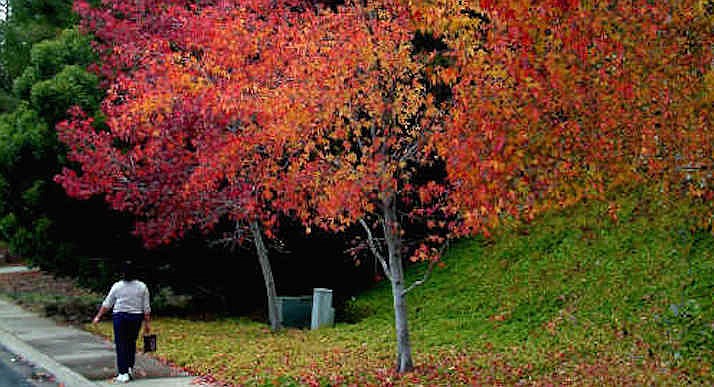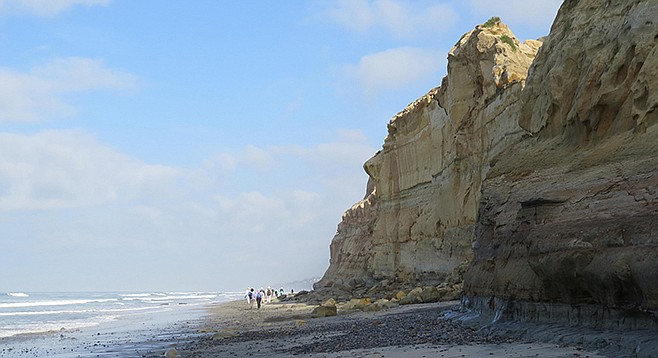 Facebook
Facebook
 X
X
 Instagram
Instagram
 TikTok
TikTok
 Youtube
Youtube

Atmospheric Ice-Crystal Effects are often observed, starting this time of year, because of the frequent appearance of high clouds made of tiny bits of ice. The most familiar of these optical effects is the 22˚-radius halo, or ring, around the sun or the moon. Less often seen is a “corona” (a colored disk around the sun or moon — not the same as the solar corona seen during total eclipse), “sundogs” (colored arcs left and right of the sun), the sun pillar (a vertical column of light above the rising or setting sun), and a host of other rare and inconspicuous optical phenomena. All of the optical effects mentioned are a consequence of sunlight or moonlight refracting through or reflecting from the tiny facets of ice crystals in cirrus and other types of high clouds.

Liquidambar Trees, or sweet gums, the deciduous trees gracing front yards, parks, and campuses throughout the San Diego area, have been putting on an exceptionally colorful show. The leaves of some varieties turn to purple or red; the leaves of other varieties fade to golden yellow. Still other varieties hold on to their green leaves until sometime in December. Most liquidambars in our area regain their light green foliage by late February.

Very Low Tides early this month coincide with good times of the day for tidepooling: Thursday, December 4, at 3:43 pm (-.87 feet); Friday at 4:30 pm (-1.15 feet); Saturday at 5:21 pm (-1.17 feet); and Sunday at 5:17 pm (-.97 feet). Very high tides will also occur within that string of days: Thursday at 9:02 am (+7.05 feet); Friday at 9:36 am (+7.29 feet); Saturday at 10:14 am (+7.31 feet); and Sunday at 9:55 am (7.08 feet).
Comet Leonard passes M3. Comet Leonard (C/2021 A1) will probably brighten to 6th magnitude by Thursday night. It will be high in the east before the very first light of dawn, crossing the Canes Venatici/Bootes border. North Americans looking on late Thursday night will find it less than 1° below the 7th-magnitude globular cluster M3. Quite an interesting visual comparison to be made, and think photo opportunity!
The above comes from the Outdoors listings in the Reader compiled by Jerry Schad, author of Afoot & Afield in San Diego County. Schad died in 2011. Planet information from SkyandTelescope.org.


Atmospheric Ice-Crystal Effects are often observed, starting this time of year, because of the frequent appearance of high clouds made of tiny bits of ice. The most familiar of these optical effects is the 22˚-radius halo, or ring, around the sun or the moon. Less often seen is a “corona” (a colored disk around the sun or moon — not the same as the solar corona seen during total eclipse), “sundogs” (colored arcs left and right of the sun), the sun pillar (a vertical column of light above the rising or setting sun), and a host of other rare and inconspicuous optical phenomena. All of the optical effects mentioned are a consequence of sunlight or moonlight refracting through or reflecting from the tiny facets of ice crystals in cirrus and other types of high clouds.

Liquidambar Trees, or sweet gums, the deciduous trees gracing front yards, parks, and campuses throughout the San Diego area, have been putting on an exceptionally colorful show. The leaves of some varieties turn to purple or red; the leaves of other varieties fade to golden yellow. Still other varieties hold on to their green leaves until sometime in December. Most liquidambars in our area regain their light green foliage by late February.

Very Low Tides early this month coincide with good times of the day for tidepooling: Thursday, December 4, at 3:43 pm (-.87 feet); Friday at 4:30 pm (-1.15 feet); Saturday at 5:21 pm (-1.17 feet); and Sunday at 5:17 pm (-.97 feet). Very high tides will also occur within that string of days: Thursday at 9:02 am (+7.05 feet); Friday at 9:36 am (+7.29 feet); Saturday at 10:14 am (+7.31 feet); and Sunday at 9:55 am (7.08 feet).
Comet Leonard passes M3. Comet Leonard (C/2021 A1) will probably brighten to 6th magnitude by Thursday night. It will be high in the east before the very first light of dawn, crossing the Canes Venatici/Bootes border. North Americans looking on late Thursday night will find it less than 1° below the 7th-magnitude globular cluster M3. Quite an interesting visual comparison to be made, and think photo opportunity!
The above comes from the Outdoors listings in the Reader compiled by Jerry Schad, author of Afoot & Afield in San Diego County. Schad died in 2011. Planet information from SkyandTelescope.org.
Comments